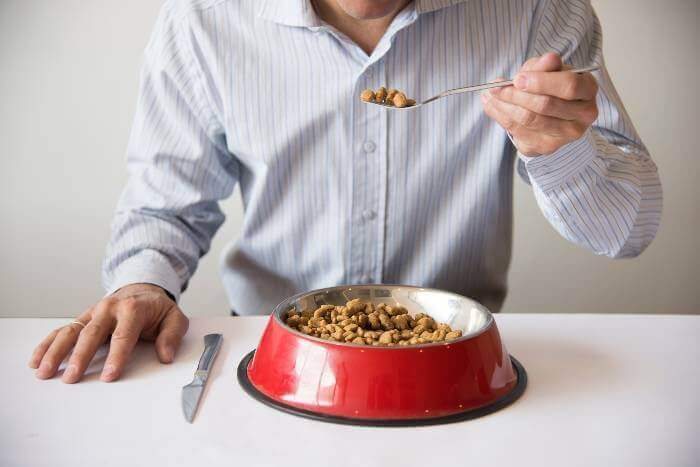What Is Human-Grade Dog Food?

DogFoodAdvisor is reader supported See how
Dog Food Advisor is 100% impartial and is never paid to promote any brand. But if you buy using links on this page, we may earn a referral fee.
Come feeding time, it’s safe to say most parents aren’t tempted to dip a fork into their dog’s food and try it for themselves. Given that a great deal of recipes aren’t strictly edible for humans, this is a good thing.
However, you may have noticed a growing number of human-grade dog foods on the market — a claim that is proudly made. Let’s face it, it does sound great. But what does it mean and is there any advantage in serving human-grade food to your pet?
To tell explain more, we asked some questions to Brandon Stapleton, a DVM and head veterinarian for 5-star-rated The Farmer’s Dog.
What’s the definition of human-grade dog food?
Human-grade dog food is made to the same safety and quality standards found in the FDA and USDA regulations for human food.
It’s important to note that the standards apply not just to the ingredients, but also to the way in which the food is prepared and the location in which it’s produced.
For example, The Farmer’s Dog food is made and tested in USDA-compliant facilities. This means it’s made alongside food made for humans and subject to the highest safety standards in the pet food industry. Very few pet foods are made to this uncompromising standard.
Can people eat human-grade dog food?
Many of us here at The Farmer’s Dog have eaten our food! All our recipes are human-grade, so they’re safe to eat. However, the food is ultimately made for dogs.
The reason we make our food to human-grade standards is not because we think people should eat it or that dogs should eat like people. We do it because it allows us, and our customers, to know exactly what’s in the food and that it’s safe and healthy for their dogs to eat. This is especially important when you’re making food that is fresh and not heavily processed.
There’s no seasoning, no special cooking techniques, no magic ingredients — It’s just that it’s made to human-food safety standards.
Can people eat non-human-grade dog food?
It’s not advisable for people to eat traditional pet food that’s not made to human-grade standards. Most pet food is made to the standard of animal feed, which means the regulations governing what can find its way into the food are not as stringent. Also, the places in which the food is made are not subject to the same strict oversight.
In fact, the CDC actually advises that you wash your hands after touching pet food and you keep it separate from human food.
Is human-grade food better for dogs?
Not necessarily. What’s really important when it comes to pet food is that it’s complete and balanced — providing all the nutrients dogs need in the right ratios. All of our recipes were developed by veterinary nutritionists to be complete and balanced according to AAFCO standards and safe to feed for all life stages with no supplementation necessary.
However, the fact our food is made to human-food safety and quality standards at every step, from ingredients to cooking and handling, means you know exactly what you’re feeding your dog, which is an important factor in a healthy diet.
So what are the advantages?
Many foods that are complete and balanced are also ultra-processed. We took decades of pet nutrition science and worked with top vet nutritionists to create recipes that are nutritionally complete and balanced for dogs, but in the form of fresh, human-grade food. We avoid the high-heat processing that’s used to make kibble and include lightly cooked meat and vegetables instead.
Our food is highly digestible which is another big factor in dogs’ health — when a diet is highly digestible that means that more of the food’s nutrients are being delivered to the dog’s body. Studies have shown that fresh, minimally processed food is more digestible and dogs eating it produce smaller poops.
Quantity also matters. Our meal plans are pre-portioned for each dog’s needs based on factors like age, body condition, and activity level, making it easier to keep your dog at an ideal weight.
This is important because managing your dog’s weight is hugely important to their health. Research shows that dogs kept at a healthy weight can actually live longer.
So, taken together, all these things make a fresh, human-grade diet a very healthy choice for dogs.
Is there a difference between human-grade and organic dog food?
Yes, these are very different things. As mentioned, human-grade speaks to the safety and quality standards that apply to all facets of making the food. There are no pet-food-specific regulations for the use of “organic” on labels.
For now, any dog food claiming to be “organic” should meet the same requirements as human food doing the same. But just because some ingredients are organic does not mean that the entire product is. To be certified organic, a food would need to contain 95% organic ingredients. A food with a lower proportion could still list certain components as organic.
But it’s worth considering what a word like “organic” seems to promise — pure, healthy food — and the reality of what pet foods labeled organic are actually delivering. Any organic ingredient in kibble is still subject to extreme processing.
Are there any grey areas when it comes to human-grade dog food?
There are companies that claim human-grade ingredients but their food is made in pet-food facilities. This misleads consumers. Truly human-grade pet food is not only made with human-grade ingredients and according to human food safety standards, but done so in a registered human food facility, made alongside human food products.
This means our facilities are regulated and inspected by both the FDA and the USDA. To put that into perspective, in the pet-food world a facility may get a government inspection only once in three to five years. In our facilities, we get inspected daily.
We do all of this because it allows us, and our customers, to know exactly what’s in the food, and that it’s safe and healthy for their dogs to eat–because it’s made to the highest safety standards available. With The Farmer’s Dog what’s on the label actually matches what’s delivered to your door.
Final word
The Dog Food Advisor does not accept money, gifts, samples or other incentives in exchange for special consideration in preparing our reviews.
However, we do receive a referral fee from online retailers (like Chewy or Amazon) and from sellers of perishable pet food when readers click over to their websites from ours. This helps cover the cost of operation of our free blog. Thanks for your support.
For more information, please visit our Disclaimer and Disclosure page.



